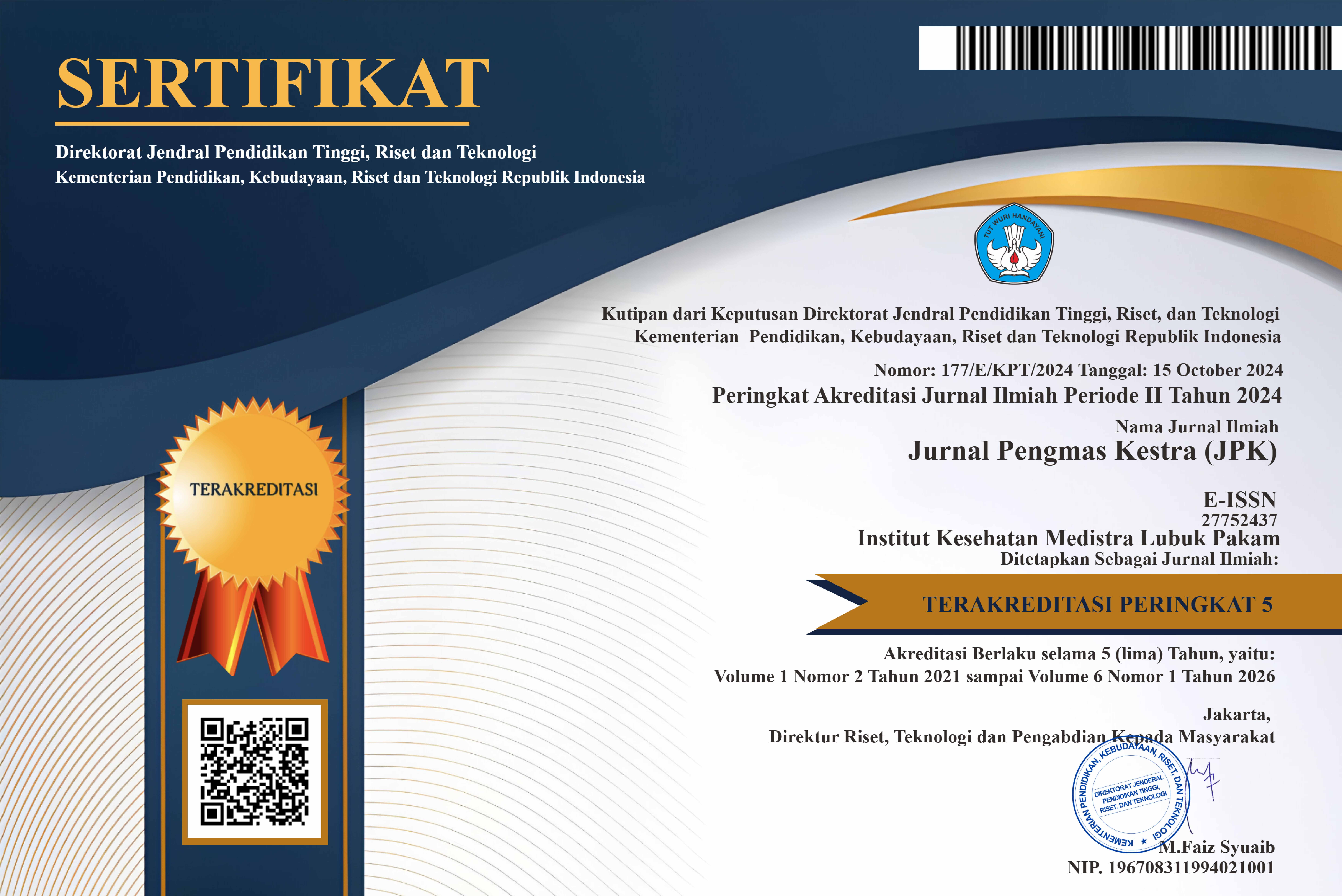Counseling on the Negative Impacts of Frequent Glue Sniffing Behavior in Children and Adolescents
DOI:
https://doi.org/10.35451/4gzr6y58Keywords:
penyuluhan, sering menghirup lemAbstract
Repeatedly sniffing glue can cause serious negative impacts, both physically, psychologically, and socially. Medically, chemicals in glue such as toluene or other solvents can damage the central nervous system, cause respiratory disorders, liver and kidney damage, and reduce cognitive function. In the long term, this habit can have an impact on decreased learning ability, emotional disorders, and even a tendency towards criminal acts. Education and socialization about the negative impacts of sniffing glue need to be carried out continuously as a preventive measure. Therefore, the author conducted educational activities in the form of counseling about the negative impacts of frequent glue sniffing behavior on children and adolescents at LKP Universal Technology Computer. This activity is a community service activity that aims to provide children with an understanding of the dangers of using glue as a substance that is abused, as well as to encourage the formation of a healthy and safe environment for children's growth and development. Counseling activities are carried out using the lecture method as the main approach in delivering the material. The percentage value of the questionnaire acquisition of the counseling participants before being given the material exposure is still in the low to moderate range where the most in the low value group with the percentage value of the questionnaire acquisition achieved from the low value group is 85% (17 participants), the moderate value group is 15% (3 participants), while the high value group is 0%. (0 participants). Furthermore, the percentage value of the questionnaire acquisition of the counseling participants after being given the material exposure obtained an increase in knowledge, namely in the moderate to high range, where the most in the high value group, with the low value group being 0% (0 participants), in the moderate value group being 45% (9 participants), then in the high value group being 55% (11 participants). This shows that the counseling activities carried out are able to increase the knowledge of counseling participants about the negative impacts of the behavior of often sniffing glue. Furthermore, it is hoped that with the delivery of this material, counseling participants can avoid and not engage in deviant behavior such as often sniffing glue (ngelem).
References
[1] Saputri, N. M. I., Amri, K., Pulungan, H. R., Daulay, I. R., Siregar, R. W., Sari, I., & Tobing, R. L., “Fenomena Pengguna Zat Adikti Inhalen (Lem) di Indonesia”, Ristekdik: Jurnal Bimbingan dan Konseling, 9(1), 126-132, 2024.
[2] Pardede, N., & Dela, V. L., “Peran Layanan Informasi dalam Mencegah Perilaku Menghisap Lem di Kelurahan Pancuran Bambu Kota Sibolga”, Ristekdik: Jurnal Bimbingan dan Konseling, 9(1), 64–68, 2024.
[3] Ananda, R., Samad, S., Anas, M., Bimbingan, J., & Makassar, U. N., ”Perilaku Menghisap Lem pada Anak Remaja ( Studi Kasus Di Desa Bonto Marannu Kecamatan Ulu Ere Kabupaten Bantaeng )”, 3(3), 2021.
[4] Hasim, D., & Mhamad, A., “Penyuluhan Hukum tentang Perilaku Menghisap Lem pada Anak Remaja di Desa Tanjun Obit Halmahera Selatan, Jurnal Pengabdian Hukum, 1(3), 1–8, 2023.
[5] Ramdhani, M. R., Yulianti, A., Ghyfari, R., Islam, U., & Datokarama, N, “Sosialisasi Bahaya Narkoba di Desa Tinggede Selatan Kecamatan Marawola Kabupaten Sigi”, Menara Kearifan: Jurnal Pengabdian Masyarakat, 3(1), 35–41, 2024.
[6] Loihala, M., & Raka, I. M., ”Pemberdayaan Masyarakat tentang Pencegahan Penggunaan Lem Aibon pada Remaja GKI Syaloom Klademak di Kelurahan Kofkerbu Wilayah Kerja Puskesmas Remu Kota Sorong”, Idea Pengabdian Masyarakat, 2(01), 09–13, 2021, https://doi.org/10.53690/ipm.v2i01.81
[7] Fadli, M., & Rasyid, F., “Peran Bhabinkamtibmas Mengurangi Kejahatan Yang Dilakukan Oleh Remaja Di Kabupaten Pinrang”, Jurnal Delik Adpertisi, 2(1), 30–40, 2023, https://jurnal.adpertisi.or.id/index.php/jda
[8] Noor, R. A., ”Perilaku Menyimpang dikalangan Remaja Penghisap Lem Fox di Kelurahan Loa Buah Kota Samarinda”, eJournal Pembangunan Sosial, 11(1), 314–324, 2023.
[9] Moento, P. A., Ririhena, S. W., & Tijilen, A. P., ”Implementasi Penanganan Masalah Sosial Pengguna Lem Aibon”, Societas, 12(2), 2023.
[10] Wijayanto, P. P., Tawai, A., & Yusuf, M., “Strategi Mengatasi Maraknya Kecanduan Menghirup Lem Aibon Pada Anak Jalanan Di Kota Kendari”. Rez Publica, 9(2), 45-53, 2023.
[11] Saputri, M. A., & Bahri, S., ”Anak Jalanan Penggunaan Lem Aibon di Kota Makassar ( Studi Fenomenologi )”, Jurnal Sosiologi Kontemporer, 3(1), 23–30, 2023.
[12] Pradani, A., & Tan, W., ”Analisis tentang Pemberian Grasi Pelaku Tindak Pidana Narkotika”. Jurnal Analisis Hukum, 5(1), 40–55, 2022, https://doi.org/10.38043/jah.v5i1.3443
[13] Djafar, L., Paramata, Y., Hafid, W., & Ali, N. H., “Penyalahgunaan Narkoba Inhalasi pada Siswa SMPN 1 Limboto”. Indonesian Journal of Health and Medical, 1(2), 179–188, 2021.
[14] Yusniar, Y., Hariani, M., & Sitohang, T. R., ”Edukasi (Penyuluhan) Bahaya Menghirup Lem pada Anak Usia Sekolah pada Kepala Lingkungan dan Ibu PKK di Kelurahan Aek Manis Kecamatan Sibolga Selatan”. Jurnal Kreativitas Pengabdian Kepada Masyarakat (PKM), 7(7), 2024, 2851–2860. https://doi.org/10.33024/jkpm.v7i7.15020.
[15] Susilo, G., Basari, S. S., Naufal, R. A., & Lexiana, R. A. V., “Peningkatan Pemahaman Pendidikan Kenakalan Remaja di Sekolah Menengah Pertama di SMP Negeri 20 Penajam Paser Utara (PPU)”, Jurnal Pengabdian Kepada Masyarakat, 4(2), 101-109, 2024..
[16] Sagala, A. I., Sartika, I., Saragih, V., & Belawan, A. M., ”Sosialisasi Perilaku Menyimpang pada Anak Remaja di SMP Asy-Syafiiyah Medan”, Jurnal Pengabdian PenMaRim, 1(April), 24–28, 2023.
[17] Rahim, M. H. P., Ismail, D. E., & Apripari, ”Hambatan Pelaksanaan Restorative Justice pada Tindak Pidana Narkotika di Kepolisian Resort Gorontalo Kota. Jaksa”, Jurnal Kajian Ilmu Hukum dan Politik, 2(2), 258–266, 2024. https://doi.org/10.51903/jaksa.v1i3.14670
[18] Rachman, F. T., Fitri, D. E., & Aggreini, S. N., “Pengaruh Pendidikan Kesehatan dengan Media Video Terhadap Pengetahuan Lem pada Remaja di MTS LKMD Giti Kec Kabun Kab. Rokan Hulu”. Jurnal Pendidikan Kesehatan, 3(1), 8-13, 2023.
[19] Loihala, M., & Raka, I. M., ”Pengaruh Penyuluhan terhadap Pengetahuan tentang Bahaya Penyalahgunaan Lem Aibon pada Remaja di Kelurahan Kofkerbu Kota Sorong”, An Idea Health Journal, 1(02), 92-96, 2022.
[20] Moreng Sidobo, M., Asih Blandina, O., & Nur Fitria, P., “Pengetahuan dan Sikap Remaja tentang Dampak Penggunaan Lem Eha-Bond di Kabupaten Halmahera Utara”, Jurnal Keperawatan Dan Kesehatan Masyarakat, 2(1), 1–10, 2022. https://doi.org/10.55984/leleani.v2i1.9
Downloads
Published
Issue
Section
License
Copyright (c) 2025 Riri Safitri

This work is licensed under a Creative Commons Attribution 4.0 International License.
Copyright in each article is the property of the Author.




















